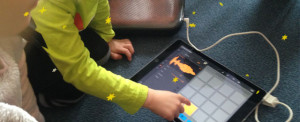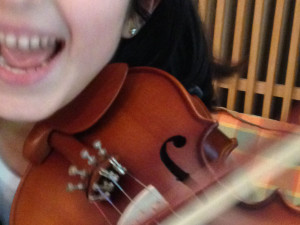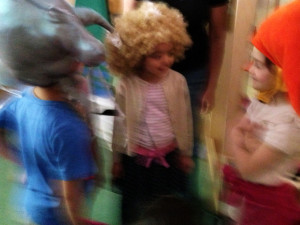Building bridges between research and practical experience
A convention of the research network Frühe Bildung (Early Education) gave impulses for Little Star.
The different topics that were being presented at the seminar at the Hochschule Stendal were also interesting for the Little Star project. That is why Christian Liebisch travelled to Stendal and there he listened to multiple presentations. He listened to presentations like “Computer im Vorschulbereich” (Computers in Pre-Primary), “Ko-Konstruktion in der Kitapraxis” (Co-Construction for the kinder garden experience) and “Sonnenschein oder Störenfried?” (Sunshine or Troublemaker?) and exactly those 3 research contributions were suitable for an exact practical comparison, Christian Liebisch states.
„Computer im Vorschulbereich” (Computers in Pre-Primary)- A lecture by Dr. Henry Herper

It seems like that the educational practice is far behind social reality. The political ideas to use IT in educational institutions have yet to be implied because there is still a lot of skepticism everywhere. But with the Little Star project things are different because the practical work in kinder gardens has progressed with the effort of using modern and innovative materials but also with the training of working with new media.
Search engines do not directly answer questions like “what is that?”. When one is looking for answers or contents on the internet there must an awareness of what he/she is looking for and most important the awareness of knowledge he/she already has. That knowledge must be integrated in a question and the “Learn-Erlebnis-Programm” (Learn-Experience-Program) specifically works on cultivating a questioning attitude. The results are always surprising because the children show skills of integrating their known knowledge into their questioning attitude.
Having to deal more with new media comes with having to make more decisions. Which of the many digital photos do I like the most? With which song can I identify with from huge selection? The “Learn-Erlebnis-Programm” (Learn-Experience-Program) has many methods of teaching children these skills for decision-making e.g. “Sternenkarten malen” (Starmap drawing) and “digitalen Fotosuchspiel” (digital photo finding game) on the other hand these methods also train the active and creative ways of working with computers.
„Ko-Konstruktion in der Kitapraxis“(Co-Construction in kinder gardens) – workshop with Prof. Dr. Annette Schmitt

No, a Nuremberg Funnel does not exist! We have to learn everything ourselves but we must also want to learn. The “Co-“in this construction always stands for a partner and learning new things works better in teamwork. When it comes to the adult’s attitude the “Co-construction” describes it perfectly. New understandings are worked out together in a playful manner, the adults are not seen as an “authority” but as a partner in the playful situation. The best example is the hand puppet game where the “Sternstunde” (star hour) is being hosted. This specific situation has a childlike tone and the adult can still be the educator whereas Little Star is curious, impatient or clueless and that ensures a dialogue with the children. Out of that dialogue a chain of thoughts is made and the question “what are thoughts?” becomes an exciting experiment. Therefore the Little Star stories can be discovered with pictures and with the many questions but also be told.
The experiences made during the “Sternstunde” (star hour) are so stimulating that the children even create their own projects from the content. Even for the adults working and pursuing the children’s ideas can be fun. All participants of the game find themselves in a mutual, exciting and enthusiastic research process.
„Sonnenschein oder Störenfried?” (Sunshine or trouble maker?) – A systematic glance on children with behavioral problems.
Dealing with children who have behavioral problems can lead to confrontational “tug-of-wars” and to overcome situations like that changing the perspective may be helpful to calm the situation down. Is it possible to gain some positive qualities from the other person’s behavior? Instead of looking at the problems, looking for solutions is the best way to resolve the matter.

What does the change of paradigm mean? The Little Star has an active welcoming culture and because of the theatrical and educational methods new attractions are created which turn a confrontational situation into an experience that excites. An example for this would be for instance during the “Wortforschungsphase” (word-research-phase) where a new word is introduced to the class but at some point the children become restless and stop paying attention and they also are not listening to the teacher anymore. The solution for a situation like this is to make information scarce because everything scarce is deemed interesting. The teacher would say something like e.g. “I will not tell you what these long, white things on the guitar are and I’m only going to say it to the wall.” The teacher does that and the kids now are alert trying to figure out what word is that the wall gets to “hear”. After a while they figure it out of course and the word is “guitar string”.
The different characters in the Lern-Erlebnis-Program (Learn-Experience-Program) also help the children with finding their yet unknown abilities. The Green Planet character helps with the preparation for research activities and the Sun character helps build up confidence for being the center of attention sometimes.
With these examples from the convention at the Hochschule Stendal shows Little Star can be indeed seen as building a bridge between research and practical experience. On the other hand the convention also provided the Little Star project with some stimulus to improve their methods and also to develop them.
